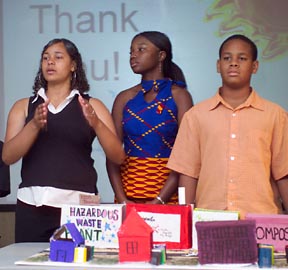Impressing Dr. J: Middle and high school students conclude month of science, exploration on the Cornell campus
By Lauren Gold

Dr. J was a hemisphere away and could not see the July 27 culmination of her students' four weeks of work in person. But from somewhere in China, thanks to modern technology, Dr. J was watching.
And that made the young presenters very nervous.
Not that Harriet, Yasmine and Val and the others wouldn't be a little jittery before delivering 30-minute presentations under the best of circumstances. But Dr. J -- otherwise known as space shuttle Endeavour astronaut Mae C. Jemison -- is the One To Impress.
She is a medical doctor, after all. And a CEO. And an author, as well as being a former NASA astronaut.
So they were all dressed in their best -- conservative skirts or khaki pants packed from home in Hackensack, Houston or Seattle for the occasion -- or, for some, bright, flowing blue-and-orange-and-gold dresses and scarves brought from home in Ghana.
The students, ages 12 through 16, have been at Cornell University since July 1 participating in The Earth We Share (TEWS), an annual international science camp founded by Jemison in 1994. This is the camp's first year at Cornell; in previous years it has been at Dartmouth College, Colorado School of Mines and Choate Rosemary Hall, among other sites.
Jemison, who earned her medical degree from Weill Cornell Medical College in 1981, came to Cornell to meet the students earlier this month. She returned for a day on July 18 to check their progress.
Meanwhile, under the guidance of four teachers and interns, each student has been researching one of two topical scientific issues. Along the way, each has learned skills like framing a question, focusing a search, gathering information from different sources and working together as a team.
On the morning of July 27, the students presented their conclusions.
The 12- through 14-year-olds, charged with finding a solution to the world's garbage problem, presented "The Four Bin Solution," complete with plans for disposing separately of hazardous, nondegradable, recyclable and organic waste.
The 15- and 16-year-olds discussed how free trade affects the environment and designed a fictional (for now) global organization to regulate pollution and monitor workers' rights.
Both groups handled audience questions with grace. Both earned Jemison's praise.
The anxiety over, then, it was time for the fun -- and reflection.
Edwin Acosta, a 16-year-old from Dover, N.J., used his time during the afternoon cultural program to discuss free trade from a personal perspective. The policy, he said, led developing world workers like his parents (who immigrated from Honduras 20 years ago) to the United States. In their time here, he said, they have seen discrimination -- and risen above it.
"Slowly, myself and others are making a better life to transcend obstacles," he said. "One of my aspirations is to go to Johns Hopkins University to study neurochemistry and bioethics -- but my greater aspiration is to repay the debt I've built up to my parents."
He will start, perhaps, by following Jemison's advice as delivered from China. "I'm excited to see what you do with this," she told the 22 students. "How you use it to move forward to a beneficial future."
The camp was funded by the Dorothy Jemison Foundation for Excellence, named in honor of Jemison's mother.
Media Contact
Get Cornell news delivered right to your inbox.
Subscribe